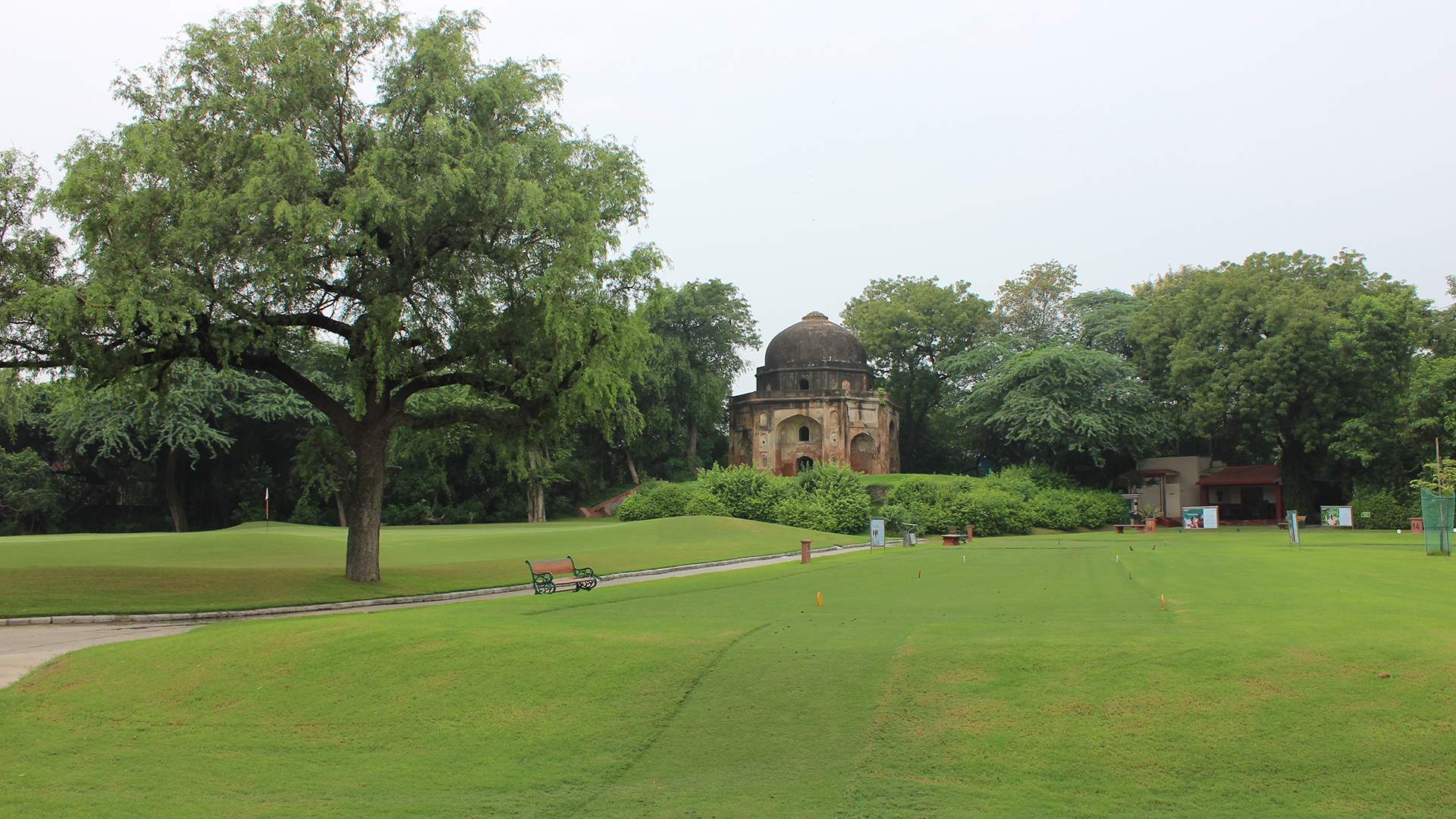Much has changed at the Delhi Golf Club to meet the needs of its ever- increasing population – well over 3,300 compared to the 80-odd soon after – Independence – but its basic character remains the same. The course that existed just prior to Independence covered a much larger area, including parts of Kaka Nagar and Golf Links, both nearby housing localities. It was a secluded spot in the midst of thick jungle. “Sometimes, as one searched for a lost ball, one stumbled upon lovers,” recalls a withered member with a glint in his eyes. Another scene of old is that of golfers arriving on bicycles with their golf bags strapped on at the back. May not be as exciting a sight as the former, but unusual all the same!
Although some land had to be sacrificed, founding members Vishnu Sahay and Dharma Vira did manage to convince Prime Minister Jawaharlal Nehru, much to the consternation of officials, to save 220 acres from being concretized.
In the early 1950s, the flat greens gave way to raised platforms, a change that did not go down very well with Peter Thomson, who was less than diplomatic when he described them as eyesores. The Aussie great made sure they were done away with when he redesigned the course in the early 1970s.
The Championship Course he carved out in 1976 had greens that merged into the landscape and did not stick out like blimps. They had gentle undulations to match the gradual slopes of the fairways. When Thomson all but won the Indian Open 1977, it was jocularly said that he had designed the History -Page 10 course to suit his game to a tee. It was another matter that he duffed the easiest of chips from the edge of the green to lose the title to his compatriot Brian Jones.
Mercifully, even when the short nine-hole course was created alongside, the designing skills of Thomson and the replacement of felled trees ensured that the forest character of the course was retained. The tree – lined fairways have been there for as long as one can remember — only the density and the hues change with changing seasons.
Some of the holes of the old course that were sacrificed to make way for the new had a lot of character and old-timers still talk about them with nostalgia. The ‘Monkey hole’ (the present 13th, so named because of the presence of monkeys) was notorious for the mysterious disappearance of balls after perfectly executed shots. On one such occasion, to which I was witness, even the affable Billoo Sethi was not spared by the furry fiends. Hundreds of enthusiasts saw Stan Peach’s ball roll back on to the green after hitting the dome of the ‘Barakhamba’ monument which provided the backdrop for the charming seventh, also known as the ‘Platform Hole’. This is now the 16th hole. It was a two-tiered green perched on a platform and surrounded by high bunkers. Because of its short length, it looked deceptively easy. One way of playing the hole was through a sand trap, hoping the ball would climb the steep bunker wall and make the green. Some did manage to pull off this game plan.
The process of re-grassing the greens with Tif-Dwarf Bermuda has just been completed. Some of the nine greens (Fourth, ninth, 10th, 11th 12th, 14th, 15th, 16th and 17th) that were taken up for change of grass, were also re- designed the re-contoured. These greens were opened recently and will settle down before the start of the Hero Honda Masters 2003. The look of some of the holes has changed as a result of the recent exercise. The History -Page 11 greens are now surrounded by a series of mounds and grassy hollows, demanding more precise play. What the DGC lacks in length (6802 yards), it makes up in its demand for precision.
The 10th green is now double-tiered. A pin placement on the top tier leaves two options-either go for a heroic shot right at the stick or play it safe to the lower tier and then face the uphill task of putting to the top of the greens. The 15th green now has three tiers, besides the hollows and the bunkers. It’s a short par-four but a sadistic pin placement can cause trouble.
Jungle is the unique feature of the DGC course, a fact impressed upon time and again by famous golfers who have lost their way on its narrow fairways.
“Its layout is unique,” said Lakshman Singh after winning the individual gold medal in the 1982 Asian Games against all odds. “The lush and narrow fairways beckon you and, at the same time, intimidate you.”
What the course lacks in length is more than made up by its tight fairways, lined on either side by trees and thick undergrowth. Even the great Payne Stewart, playing the Indian Open here in 1981, put away his Woods going into the final round with a handly lead. It certainly helped: he won!
For the statistically inclined, the average width of the fairways is 25 yards, the narrowest point being only 14 yards on the 16 th fairway and the widest being 33 yards, on the first. The fairways are lush and the ball sits up nicely. This makes approach shots easier and conducive to attacking golf.
The total green area of the Delhi Golf Club is 179 acres. Two couses were carved out of this area in 1976 when Peter Thomson redesigned the course, giving it a championship course (Lodhi) spread over 140 acres and a short course (Peacock) on the remaining 39 acres. The length of the championship course is 6802 yards.
Given the fact that of the 140 acres, 56 acres (almost 40 per cent) of land is covered by forest, one can visualize the extent of the jungle. Life is not made any easier by the thorny bushes which form the undergrowth in the forest. Torn shirts, bruised arms and battered egos are what one gets for straying into Cobra country. There are hundreds of tree species on the course, of which 44 are major ones. The many shades of green interspersed with flowering trees of different hues are an exquisite feature of the course.
The layout has no water hazards. The only one that existed – at the short seventh – was covered and replaced by small mounds when it was discovered that street kids had started scaling the wall and using the tank for frolicking, batching and other odd jobs.
Some experts believe that once you have learnt to cope with the narrow, tree-lineds fairways, the course can be mastered, what with no water hazards and not many bunkers. Currently, the total number of bunkers is 63, averaging about 3.5 per hole. Compare this to 90 at the Nicklaus-designed Classic Golf Resort and 86 at the Jaypee Greens, a Greg Norman creation.
The greens are fairly large in size and are currently in a state of transition. Only nine greens have been re-grassed with Tifdwarf Bermuda while the remaining are covered by Bermuda Selection I. Once the process of re-grassing is completed this summer, all 18 greens will have truer and faster putting surfaces which will be comparable with greens on international courses.
Many believe that a major factor in Ali Sher’s wins here in 1991 and 1993 was his intimate knowledge of the relatively slow greens. Once the character of the greens is altered, we will know if this was indeed the case.
Ramesh R. Kohli
Golf Digest India November 2003
The DGC’s central location makes it one of the busiest courses in the world and it speaks volumes for both, its members and turf managers that the course is in good shape and has been continuously upgraded over the last 13- 14 years. It is no coincidence that both the Asian Tour and the European Tour have chosen DGC as a venue for staging the Indian Open and the Indian Masters, respectively. What the course lacks in length – it is 7,036 yards from the Black Tees – is more than made up by its tight fairways, lined on either side by trees and thick undergrowth. The average width of the fairways is 25 yds, the narrowest point being only 14 yds on the 16 th fairway.
When quizzed about his views, Ali Sher says; “Is course ka koi Hindustan mein muqabala nahin, duniya mein nahin.”
“For its unique layout and ambience, overall I would rate the DGC as the best. It is truly a great championship course” – Gaurav Ghei, leading professional
Adding bite
The Lodhi Course gets a makeover as Delhi Golf Club prepares to welcome Ernie Els and Co.
Every time changes are contemplated to tighten the Lodhi Course, opinion is sharply divided. While the club golfer feels life is being made difficult for him, experts believe the DGC is a tad easy by international standards. Only a couple of years ago, tees were pushed back, and greens enlarged and surrounded by grassy hollows, to make the course more challenging. Jyoti Randhawa’s winning score of 22-under-par in the AIS Open in 2007 buttressed the argument of those who believed that because of its relatively short length, the likes of Ernie Els would massacre the course.
After several course inspections by European Tour officials, and discussions with the course management team at DGC headed by the Captain and the Course Manager – the first of which took place before the 2007 Indian Open – it was decided to make some changes, albeit only for the Indian Masters.
As a first step, three new tees were put in place – on the third, seventh and 10 th holes. This increased the length of the course by 126 yards, from 6888 to 7014 yards. The new tees were used in the final two rounds of the Indian Open in 2009. As a result, the scores on those holes were marginally higher.
If we thought the Lodhi fairways are narrow because of the jungle lining the fairways – thus placing a premium on accuracy – the experts thought otherwise! The near-unanimous view was to make the fairways narrower, using the first cut to achieve this.
Compared to European and other international courses, the DGC has very few greenside bunkers and almost no fairway bunkers. After a lot of deliberation, it was decided to construct bunkers on the first, sixth, eighth, and 18th fairways, so that the drive would have to be carefully positioned on these holes.
The new bunkers are at a distance of 280 to 300 yards from the tree. The sand traps are large in size and will definitely add to the challenge. The one on the first is 2050 sq.ft., and those on the eighth and 18th are 1850 and 1750 sq.ft., respectively. The 18th, which, at 545 yards, is the longest hole on the course, will become a very existing finishing hole.
Two bunkers have been constructed on the 401-yard sixth across almost half the fairway. This is in addition to the exciting fairway bunkers. At the highest point, the bunkers are five to six feet deep. Sadly, Dr. Bharat Ram, who for long advocated having more bunkers on the Lodhi Course, will not be there to see the new look.
Last but not the least, the course will, for the first time on its history, play as par 71. The 416 – yard 14th, which is a straight par 5 hole, was considered far too easy and has been reduced to a par 4 for the Indian Masters.
Ramesh R. Kohli
Golf Digest India February 2009

